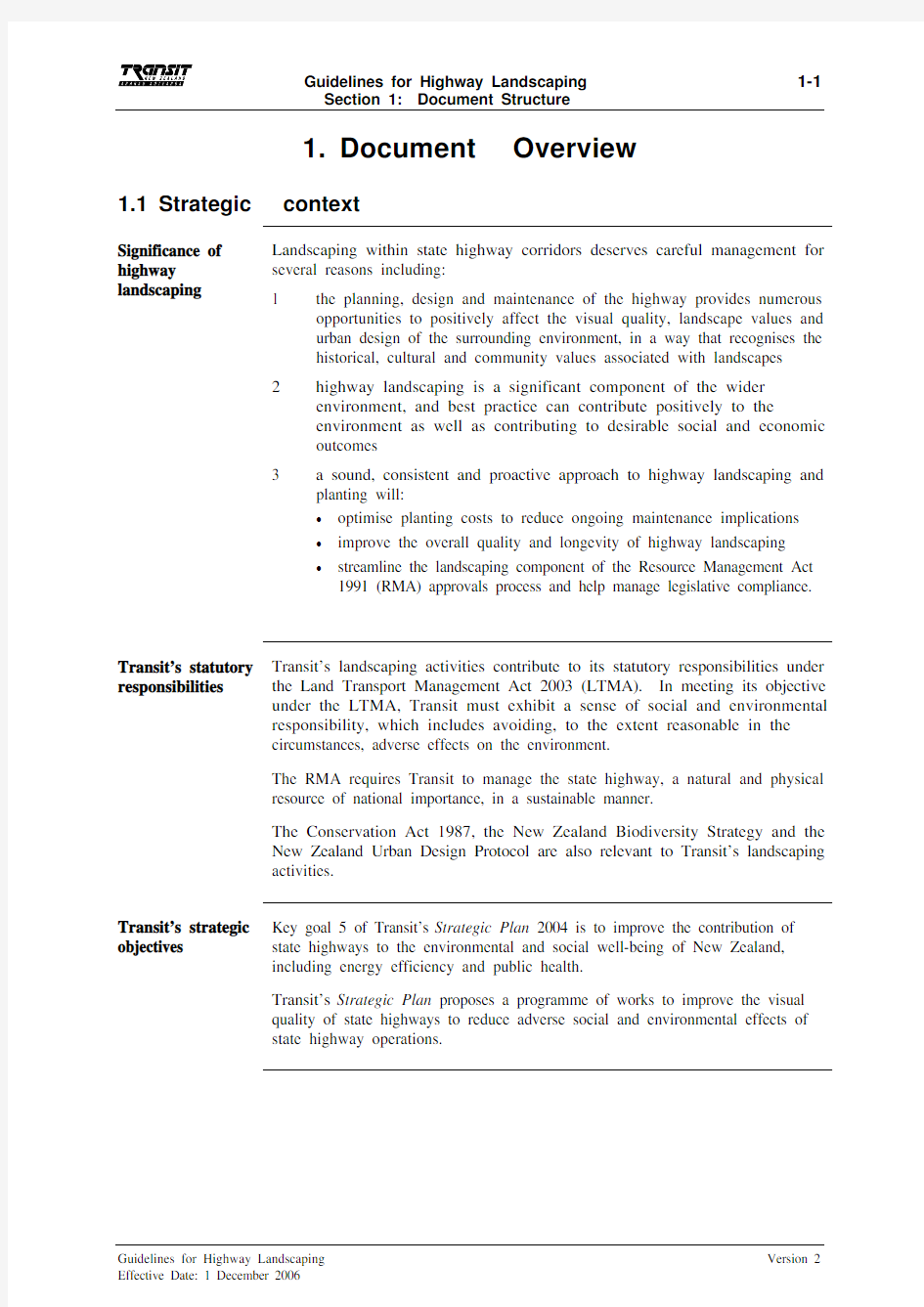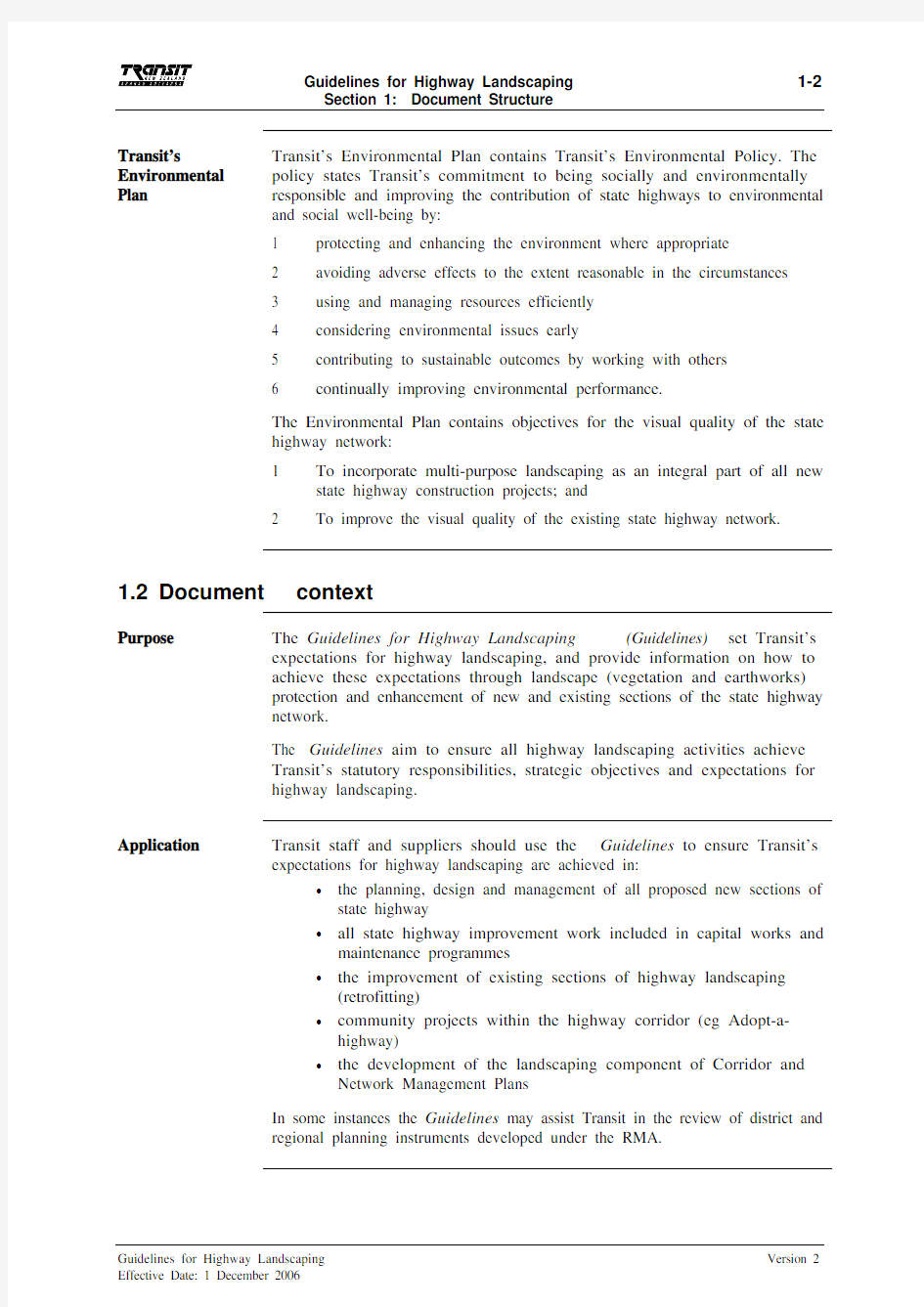

1. Document Overview
1.1 Strategic context
Significance of
highway landscaping
Landscaping within state highway corridors deserves careful management for several reasons including: 1
the planning, design and maintenance of the highway provides numerous opportunities to positively affect the visual quality, landscape values and urban design of the surrounding environment, in a way that recognises the historical, cultural and community values associated with landscapes 2
highway landscaping is a significant component of the wider environment, and best practice can contribute positively to the environment as well as contributing to desirable social and economic outcomes
3
a sound, consistent and proactive approach to highway landscaping and planting will:
? optimise planting costs to reduce ongoing maintenance implications ? improve the overall quality and longevity of highway landscaping
? streamline the landscaping component of the Resource Management Act 1991 (RMA) approvals process and help manage legislative compliance.
Transit’s statutory responsibilities
Transit’s landscaping activities contribute to its statutory responsibilities under
the Land Transport Management Act 2003 (LTMA). In meeting its objective under the LTMA, Transit must exhibit a sense of social and environmental responsibility, which includes avoiding, to the extent reasonable in the circumstances, adverse effects on the environment.
The RMA requires Transit to manage the state highway, a natural and physical resource of national importance, in a sustainable manner.
The Conservation Act 1987, the New Zealand Biodiversity Strategy and the New Zealand Urban Design Protocol are also relevant to Transit’s landscaping activities.
Transit’s strategic objectives
Key goal 5 of Transit’s Strategic Plan 2004 is to improve the contribution of
state highways to the environmental and social well-being of New Zealand, including energy efficiency and public health.
Transit’s Strategic Plan proposes a programme of works to improve the visual quality of state highways to reduce adverse social and environmental effects of state highway operations.
Transit’s Environmental Plan Transit’s Environmental Plan contains Transit’s Environmental Policy. The policy states Transit’s commitment to being socially and environmentally responsible and improving the contribution of state highways to environmental and social well-being by:
1 protecting and enhancing the environment where appropriate
2 avoiding adverse effects to the extent reasonable in the circumstances
3 using and managing resources efficiently
4 considering environmental issues early
5 contributing to sustainable outcomes by working with others
6 continually improving environmental performance.
The Environmental Plan contains objectives for the visual quality of the state highway network:
1 To incorporate multi-purpose landscaping as an integral part of all new
state highway construction projects; and
2 To improve the visual quality of the existing state highway network.
1.2 Document
context
Purpose The Guidelines for Highway Landscaping(Guidelines) set Transit’s expectations for highway landscaping, and provide information on how to
achieve these expectations through landscape (vegetation and earthworks)
protection and enhancement of new and existing sections of the state highway
network.
The Guidelines aim to ensure all highway landscaping activities achieve
Transit’s statutory responsibilities, strategic objectives and expectations for
highway landscaping.
Application Transit staff and suppliers should use the Guidelines to ensure Transit’s expectations for highway landscaping are achieved in:
? the planning, design and management of all proposed new sections of
state highway
? all state highway improvement work included in capital works and
maintenance programmes
? the improvement of existing sections of highway landscaping
(retrofitting)
? community projects within the highway corridor (eg Adopt-a-
highway)
? the development of the landscaping component of Corridor and
Network Management Plans
In some instances the Guidelines may assist Transit in the review of district and
regional planning instruments developed under the RMA.
Relationship with other documents The Guidelines are one component of Transit’s approach to state highway management and should not be viewed in isolation.
The Guidelines should be read in conjunction with other relevant documents such as:
? Environmental Policy Manual (SP/M/023)
? State Highway Geometric Design Manual (SP/M/024)
? State Highway Safety Management System Manual (SP/M/002)
? Code of Practice for Temporary Traffic Management (SP/M/010)
? State Highway Maintenance Contract Proforma Manual (SM/032)
? State Highway Construction Contract Proforma Manual (SM/031)
? SOMAC Specification for Vegetation Control (SM032 VC 09)
? State Highway Control Manual (SM/012)
? Planning Policy Manual (SP/M/001)
Transit’s Standards and Guidelines Manual (SP/M/021) is a comprehensive listing of all Transit’s manuals and technical documents.
Document
Structure
Status Version 2 of the Guidelines for Highway Landscaping has the status of a Guideline as defined in Transit’s Standards and Guidelines Manual. Guidelines
may be modified to suit particular circumstances so that optimal environmental,
economic or resource-use impacts result. Because guidelines are recommended
best practice, they require judgement when applied to particular circumstances.
Any variation from the Guidelines should be justified and recorded in
consultation with the Transit project manager.
Version 2 replaces Version 1 in its’ entirety.
Contact point for feedback We encourage and welcome feedback on the content or application of the Guidelines to assist in future reviews.
Feedback should be directed to:
National Standards Manager
Transit New Zealand
PO Box 5084
WELLINGTON
Email: landscaping@https://www.doczj.com/doc/1a8543451.html,